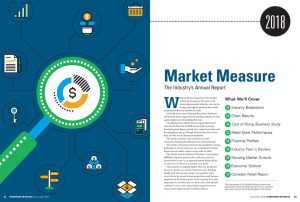
Click the picture to download a PDF of this story.
The Industry’s Annual Report
While 2018 has shaped up to be another relatively strong year for sales in the home improvement industry, we may be facing a perception problem that could temper growth in the months to come.
Let’s talk about some of the positive forces that have allowed the home improvement retailing industry to once again outpace overall retailing this year.
The driving force behind home improvement retail sales for the first half of 2018 has been the economy. Unemployment figures remain low, wages have risen and housing prices are up. Though interest rates have risen, they are still low by historical standards.
This good economic news translates to more consumers buying and selling homes and renovating.
The positive housing momentum has resulted in strong performance. Every source we use to monitor the home improvement market reports strong sales in 2018.
The North American Retail Hardware Association (NRHA) estimates predict that industry sales for 2018 should come in at approximately $394 billion, an increase of about 5.5 percent over 2017.
This number is slightly higher than we predicted last year, partly as a result of interest rates holding steady and also because of the way product sales were driven by record storm preparation and damage experienced in various parts of the country. It is also important to consider that we have seen, and should continue to see, some upward pricing pressures on many home improvement-related products.
By all accounts, the industry is shaping up to have another strong year this year, remaining a slight step ahead of overall retail sales.
Looking solely at government statistics for the industry, the projected figure for the year is relatively similar to NRHA’s, with total sales estimated around $394.6 billion for 2018—a 4.4 percent increase from the U.S. Census Bureau figures from last year.
Lastly, estimates from the Home Improvement Research Institute (HIRI) show industry sales for 2018 totaling approximately $398.2 billion, a 6.3 percent increase over last year’s performance.
By all accounts, the industry is shaping up to have another strong year this year, remaining a slight step ahead of overall retail sales.
For industry retailers, there are a few important points to note. Overall, it appears professional purchases are growing at a much faster clip than consumer purchases. In fact, according to HIRI, industry sales to pros will grow at about 9.9 percent in 2018, compared to just 4.7 percent for consumers.
This data shouldn’t be surprising as homebuilding and larger remodeling projects taking place during a healthy economic cycle are tied to pro purchases.
At the retail level, we see a greater percentage of home improvement sales going online. In fact, Home Depot grew its online sales by 23.1 percent during the first six months of fiscal 2018, according to a company report. Both Home Depot and Lowe’s have made ongoing efforts to grow their online presence, offering services such as buy online, pick up in store.
Even as online sales capture more of the retail home improvement market, it’s important to note that the two largest online sellers of home improvement products, Home Depot and Lowe’s, are still anchored in the brick-and-mortar world.
While Amazon has seen its sales of tools and home improvement items increase in recent years, its total 2017 sales of $6.1 billion are still dwarfed by online sales through brick-and-mortar-based retailers like Home Depot, which recorded online sales of $24.9 billion in the first quarter alone, according to GlobalData Retail.
On the Horizon
The return of the housing market, solid employment numbers and still-steady interest rates have helped home improvement retailing remain strong.
However, one thing we have learned over the last few decades is that all good things must come to an end.
The billion-dollar question is, will the end of the expansion period for the industry appear suddenly or will we see a gradual erosion in growth?
Our analysis suggests that we might be in store for the latter. We might start to enter a more subdued growth cycle as early as late 2019 or 2020.
So, what are some of the factors we will need to watch for?
How the Federal Reserve deals with interest rates will be a major concern in the months ahead. According to The Conference Board, a global research group, “growth will encounter more headwinds in 2019, especially with the Federal Reserve set to raise interest rates four more times by the end of next year.”
And while the impact of rising interest rates might start to blunt momentum found within the housing market as early as 2019, there is another less-tangible headwind facing the industry: the wait-and-see consumer.
Wait-and-see consumers are people who, even with affordable housing, interest rates at a manageable level and a strong economic outlook, are still waiting to invest in the housing market in earnest.
According to the National Association of Realtors, “in the third quarter of 2018, 63 percent of people believe that now is a good time to buy a home, which is the lowest percent recorded” since 2015. Reluctance to buy is even more evident in consumers under the age of 34, the National Association of Realtors reports.
NRHA is predicting softer growth for the industry over the next two or three years because of looming interest rate hikes, consumers already hedging on whether to buy a home and another election cycle getting ready to ramp up in late 2019. By 2022, we expect the home improvement retail market could be seeing growth in the high 3 percent range.
 Hardware Retailing The Industry's Source for Insights and Information
Hardware Retailing The Industry's Source for Insights and Information






